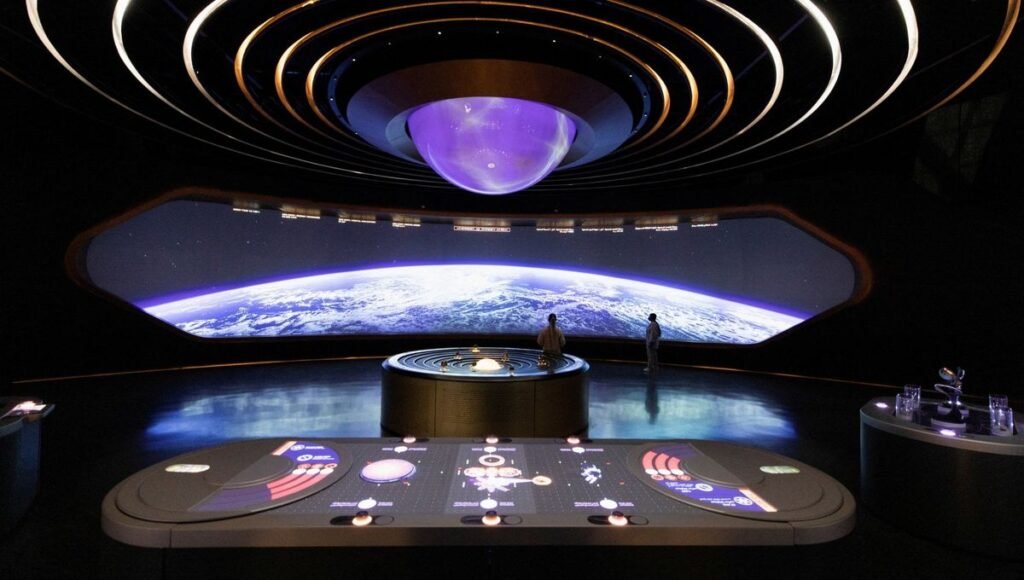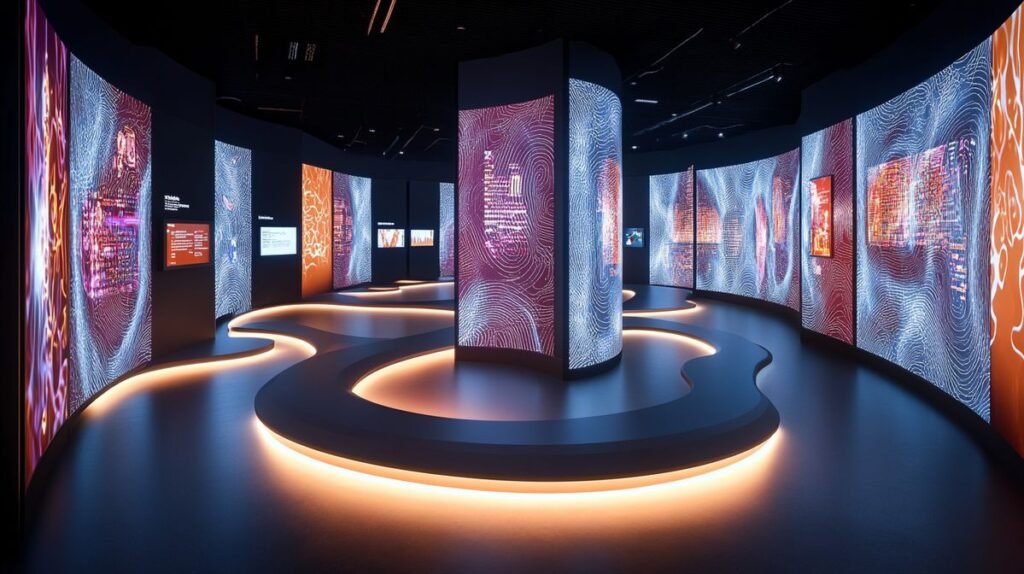Meta Description
Discover how Cultural Spaces: Museums and Galleries as Design Statements redefine luxury interiors with modern décor, statement lighting, and bespoke design ideas.

Introduction
Cultural Spaces: Museums and Galleries as Design Statements are more than just buildings that house art—they are masterpieces in their own right. A museum or gallery today is not only a container for cultural treasures but also a stage for modern décor, architectural innovation, and luxury interiors that tell their own story. By blending heritage with contemporary design ideas, these spaces demonstrate how walls, light, and finishes can evoke emotion as powerfully as the works displayed within them.
The Architecture of Cultural Identity
Museums and galleries are built to narrate cultural identity as much as to preserve history. Architectural details such as soaring atriums, sculptural facades, and textured fabrics in interior schemes transform them into symbols of national pride and creativity.
Designers of these spaces often:
- Frame history through elegant finishes that echo tradition.
- Employ natural elements like stone, wood, or water features to connect past narratives with present-day sensibilities.
- Integrate bespoke furniture and installations that blur the line between object and exhibit.
These touches elevate cultural institutions into luxury interiors—where every corridor, hall, and gallery becomes a visual statement.
The Power of Light and Space
One of the most striking features of modern cultural design is the orchestration of light. In cultural spaces, light is not merely functional—it’s theatrical.
Statement Lighting as a Curator
Curators now collaborate with designers to employ statement lighting that highlights artwork while also shaping the visitor’s journey. Skylights, reflective pools, and hidden LEDs all bring drama to otherwise silent halls. This careful calibration creates intimacy in one corner and grandeur in another.
Open-Plan Living for Public Spaces
Borrowing from residential design trends, many cultural venues embrace open-plan living concepts. Expansive halls with uninterrupted sightlines offer fluid movement, encouraging visitors to wander, pause, and discover. This design idea enhances both accessibility and emotional resonance, making the experience feel effortless yet deeply engaging.
Luxury Interiors Beyond the Exhibit
What distinguishes a gallery or museum as a design statement is not only its displays but also the seamless experience it offers visitors. Every bench, stairwell, or café becomes part of the aesthetic composition.
- Textured fabrics on seating invite tactile engagement.
- Designer touches in flooring patterns echo the geometry of the artworks on the walls.
- Stylish upgrades such as immersive projection rooms or sculptural staircases heighten the sense of wonder.
The best cultural interiors move beyond neutrality; they are active participants in storytelling.
Design Ideas for the Next Generation of Cultural Spaces
Cultural institutions worldwide are experimenting with bold new approaches. Here are a few forward-looking design ideas:
1. Immersive Architecture
Walls double as digital canvases, transforming static halls into dynamic storyboards. Projection technology meets architecture, producing spaces that are at once traditional and futuristic.
2. Sustainability as Luxury
Green roofs, recycled materials, and natural elements like daylight harvesting redefine what it means to be a luxury space. Environmental responsibility now pairs with elegance, proving that sustainability is the ultimate stylish upgrade.
3. Bespoke Social Zones
Instead of sterile waiting areas, lobbies transform into lounges furnished with bespoke furniture, warm textures, and contemporary art. These zones invite conversation and encourage cultural exchange long before visitors reach the main exhibit.
Cultural Spaces as Urban Icons
Cities increasingly recognize museums and galleries as landmarks. Think of the Louvre Abu Dhabi with its latticed dome filtering light like a modern-day oasis, or the Guggenheim Bilbao with its undulating titanium curves. These are not just buildings—they are design statements that anchor entire neighborhoods.
For luxury design enthusiasts, they provide lessons in how scale, materiality, and artistry can turn even public institutions into icons of modern décor.
Conclusion
Cultural Spaces: Museums and Galleries as Design Statements remind us that design is never incidental—it is integral to storytelling. From architectural details to statement lighting, from elegant finishes to bespoke furniture, these institutions exemplify how interiors can be both functional and poetic. At Good House Interiors, we bring the same philosophy to private projects, creating environments where every element speaks with intention. Whether you’re seeking space planning, living room transformations, or custom-crafted furniture, we specialize in delivering interiors that resonate like cultural landmarks of their own.
FAQs
1. How do museums and galleries influence modern décor trends?
They set benchmarks for luxury interiors, showcasing bold design ideas such as open-plan layouts, textured fabrics, and innovative lighting that often trickle into high-end residential and commercial design.
2. Why is lighting so critical in cultural spaces?
Statement lighting not only illuminates artwork but also frames the visitor’s emotional journey, creating drama, intimacy, and cohesion throughout the space.
3. Can sustainability still feel luxurious in cultural interiors?
Absolutely. By integrating natural elements, recycled materials, and elegant finishes, cultural spaces prove that eco-consciousness can be the most refined form of modern décor.
4. What role does bespoke furniture play in galleries?
Bespoke furniture adds functionality without compromising aesthetics, blending seamlessly into the narrative of the space while offering comfort and designer touches.
5. How can Good House Interiors bring cultural space inspiration into private projects?
We reinterpret principles from iconic museums—such as architectural details and stylish upgrades—and translate them into residential and commercial projects tailored to your lifestyle.

المساحات الثقافية: المتاحف والمعارض كبيانات تصميم
المقدمة
إن المساحات الثقافية: المتاحف والمعارض كبيانات تصميم ليست مجرد مبانٍ لعرض الأعمال الفنية، بل هي بحد ذاتها تحف معمارية. فالمتحف أو المعرض الحديث لم يعد مجرد وعاء يحفظ المقتنيات، بل أصبح منصة للديكور العصري، والابتكار المعماري، والفخامة الداخلية التي تروي قصة متكاملة. ومن خلال الدمج بين التراث والأفكار التصميمية المعاصرة، تتحول الجدران والإضاءة والتفاصيل إلى عناصر تُثير المشاعر تماماً كما تفعل الأعمال الفنية المعروضة.
العمارة كهُوية ثقافية
تعكس المتاحف والمعارض الهوية الثقافية بقدر ما تحفظ التاريخ. فالتفاصيل المعمارية مثل الردهات الواسعة، والواجهات النحتية، والأقمشة الملمسية في التصميمات الداخلية تجعلها رموزاً للفخر الوطني والإبداع.
- إبراز التاريخ من خلال تشطيبات أنيقة تُحاكي الأصالة.
- دمج العناصر الطبيعية مثل الحجر والخشب والمسطحات المائية لربط الماضي بالحاضر.
- استخدام الأثاث المفصّل حسب الطلب ليصبح جزءاً من العرض الفني نفسه.
هذه اللمسات ترفع من قيمة المؤسسات الثقافية لتصبح مساحات فاخرة تُقدَّم فيها التجربة البصرية بمستوى عالمي.
قوة الضوء والفضاء
أحد أكثر العناصر لفتاً للانتباه في التصميم الثقافي الحديث هو التحكم في الضوء. فالإضاءة هنا ليست مجرد وظيفة عملية، بل هي عنصر مسرحي.
الإضاءة المميزة كأداة للعرض
يتعاون القيّمون مع المصممين لاستخدام إضاءة مميزة تسلط الضوء على الأعمال وتوجه رحلة الزائر. من السقوف الزجاجية إلى البرك العاكسة والمصابيح الخفية، كلها تُضفي دراما وتُنشئ أجواء حميمة في مكان، ومهيبة في مكان آخر.
المساحات المفتوحة في الفضاءات العامة
على غرار اتجاهات التصميم السكني، باتت العديد من المؤسسات الثقافية تعتمد مفهوم المساحات المفتوحة. القاعات الواسعة ذات الرؤية الممتدة تُسهل حركة الزوار وتشجعهم على الاكتشاف الحر. هذه الفكرة تعزز سهولة الوصول وتضاعف الأثر العاطفي للتجربة.
الفخامة الداخلية خارج قاعات العرض
ما يجعل المتحف أو المعرض بياناً تصميمياً ليس المعروضات فقط، بل التجربة الكاملة. فكل مقعد، درج، أو مقهى يتحول إلى جزء من التكوين الجمالي.
- الأقمشة الملمسية في المقاعد تُشجع على التفاعل الحسي.
- اللمسات المصممة بعناية في أنماط الأرضيات تعكس أشكال الأعمال الفنية.
- الترقيات الأنيقة مثل الغرف التفاعلية أو السلالم النحتية تُضفي شعوراً بالدهشة.
أفضل التصاميم الداخلية الثقافية لا تكتفي بالحياد، بل تُشارك في السرد القصصي بفاعلية.
أفكار تصميمية للجيل القادم من المساحات الثقافية
تخوض المؤسسات الثقافية حول العالم تجارب جريئة في التصميم. ومن أبرز الأفكار التصميمية المستقبلية:
١. العمارة الغامرة
الجدران تتحول إلى شاشات رقمية، مما يخلق مساحات تقليدية وحديثة في الوقت نفسه، حيث يندمج السرد الفني مع التكنولوجيا.
٢. الاستدامة كفخامة
الأسطح الخضراء، والمواد المعاد تدويرها، والعناصر الطبيعية مثل الإضاءة الطبيعية تعيد تعريف الفخامة. فالاستدامة اليوم أصبحت الترقية الأكثر أناقة.
٣. مناطق اجتماعية مصممة خصيصاً
بدلاً من الردهات التقليدية، تتحول البهوات إلى صالات مريحة مزودة بـ أثاث مفصّل حسب الطلب وأجواء دافئة وأعمال فنية معاصرة، مما يعزز التفاعل الثقافي قبل الوصول إلى قاعات العرض.
المساحات الثقافية كرموز حضرية
باتت المدن تدرك أن المتاحف والمعارض هي معالم بارزة. يكفي النظر إلى متحف اللوفر أبوظبي بقُبته المخرمة التي تنثر الضوء كواحة عصرية، أو متحف غوغنهايم بلباو بخطوطه المنحنية من التيتانيوم. هذه ليست مبانٍ وحسب، بل بيانات تصميم تُشكل هوية حضرية كاملة.
بالنسبة لعشاق التصميم الفاخر، فهي دروس في كيفية استخدام الحجم، والخامات، والفن لتحويل المؤسسات العامة إلى أيقونات ديكور عصري.
الخاتمة
تُثبت المساحات الثقافية: المتاحف والمعارض كبيانات تصميم أن التصميم ليس تفصيلاً ثانوياً بل جزءاً أصيلاً من السرد. فمن التفاصيل المعمارية إلى الإضاءة المميزة، ومن التشطيبات الأنيقة إلى الأثاث المفصّل، تُظهر هذه المؤسسات كيف يمكن للتصميم الداخلي أن يجمع بين الوظيفة والشعرية. في Good House Interiors، نعتمد نفس الفلسفة في مشاريعنا الخاصة، لنبتكر بيئات يعكس كل عنصر فيها معنى مقصوداً. سواء كنت تبحث عن تخطيط للمساحات، أو تصميم راقٍ لغرف المعيشة، أو أثاثاً مخصصاً، نحن نُترجم الإلهام الثقافي إلى فخامة شخصية تُشبه بصمتك الخاصة.
الأسئلة الشائعة
١. كيف تؤثر المتاحف والمعارض على اتجاهات الديكور العصري؟
إنها تضع معايير الفخامة الداخلية، حيث تُبرز أفكار تصميمية مثل المساحات المفتوحة، الأقمشة الملمسية، والإضاءة المبتكرة التي تنتقل لاحقاً إلى المنازل والمشاريع الراقية.
٢. لماذا تُعد الإضاءة مهمة جداً في المساحات الثقافية؟
لأن الإضاءة المميزة لا تكتفي بعرض الأعمال الفنية بل تُشكل رحلة الزائر العاطفية، فتخلق دراما في مكان ودفئاً في آخر.
٣. هل يمكن أن تكون الاستدامة جزءاً من الفخامة في التصميم الداخلي الثقافي؟
بالتأكيد. إذ تُثبت العناصر الطبيعية والمواد المعاد تدويرها أن الوعي البيئي يمكن أن يكون أرقى أشكال الديكور العصري.
٤. ما دور الأثاث المفصّل حسب الطلب في المعارض؟
يُضيف الأثاث المفصّل وظيفة عملية دون المساس بالجماليات، فهو يندمج في السرد ويُقدم راحة مع لمسات مصممة بعناية.
٥. كيف يمكن لـ Good House Interiors إدخال إلهام المساحات الثقافية في المشاريع الخاصة؟
نُعيد تفسير مبادئ المتاحف العالمية—مثل التفاصيل المعمارية والترقيات الأنيقة—لنترجمها إلى مشاريع سكنية وتجارية تُناسب أسلوب حياتك.
